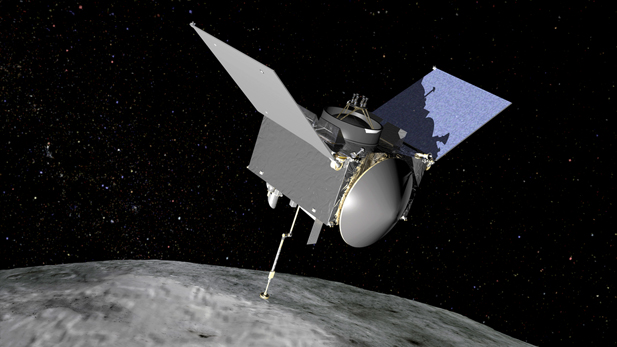 An artist's conception of the OSIRIS-REx spacecraft at the asteroid Bennu
An artist's conception of the OSIRIS-REx spacecraft at the asteroid BennuThe University of Arizona’s ambitious mission to send a spacecraft to grab a soil sample from an asteroid is a first for U.S. planetary exploration. The spacecraft is scheduled to launch Thursday.
The mission is called OSIRIS-REx, and its aim is to go to an asteroid named Bennu, map the half-mile-wide asteroid’s surface and then sweep up a dirt sample and bring it to Earth. That will take seven years total.
“Bennu is a carbon-rich, near-earth asteroid that holds the record of the formation of the solar system and can answer some fundamental questions about the origins of our solar system and our planet,” said NASA’s OSIRIS-REx program executive Gordon Johnston.
The spacecraft will get at least 60 grams, or 2 ounces, of material from the asteroid’s surface. The instrument has successfully collected 300 grams in tests. The sample return capsule can hold more than 4 pounds of the rocky material, which scientists call regolith.
OSIRIS-REx was conceived 12 years ago by the late Michael Drake, then head of the UA’s Lunar and Planetary Lab. He chose a young meteorite scientist, Dante Lauretta, to be his deputy. In 2011, several months after NASA decided to fund the mission, Drake died and Lauretta was selected to take over.
“OSIRIS-REx is bringing back samples closer to home and probably the likely candidates that delivered these key prebiotic compounds to our Earth and help us understand why we are here, how we are here and how likely it is that this kind of process, origin and evolution of life may have occurred elsewhere in the solar system and even throughout the galaxy,” Lauretta said.
In layman’s terms, that means asteroids may have contributed critical elements, including carbon and water ice, that led to the emergence of life.
Once it reaches the asteroid and sends back signals, the scientists will use the spacecraft’s instruments to study it from top to bottom and side to side, a process that will take two years. The gear on board includes cameras built by the UA and a spectrometer provided by Arizona State University.
“We’re going to get to asteroid Bennu and we’re going to map this brand new world that we’ve never seen before. We’ve got an extensive suite of cameras, we’ve got our laser altimeter from the Canadian Space Agency, the spectrometers and the spacecraft itself,” Lauretta said.
He said the main purpose of the mapping is to pick the best spot to get the soil sample.
“We’re really going to understand the distribution of materials across the surface of that asteroid, which is going to be critical for characterizing regions of interest on the surface and ultimately making that key decision, which is, ‘Where on this mountain-sized asteroid in space are we going to go down and get those precious 60 grams or more of material for our science?’”
Before OSIRIS-REx gets to the asteroid Bennu, a lot must happen. The countdown to launch is underway at Cape Canaveral, Florida. Here’s what will be happening this week.
On Tuesday, the team is conducting its final launch-readiness review. Tuesday and Wednesday, the science team meets to go over what will happen in the next 12 months and discuss activities once OSIRIS-REx arrives at the asteroid in 2018. Tuesday night, everyone involved with the mission will gather on Cocoa Beach for a party.
Early Wednesday, the fully assembled launch vehicle, the two-stage rocket and the booster with OSIRIS-REx atop, will be rolled out to the launch site and fueled.
Thursday evening, launch officials and meteorologists will watch the sky, anticipating the moment when the engines of the rocket ignite.

By submitting your comments, you hereby give AZPM the right to post your comments and potentially use them in any other form of media operated by this institution.